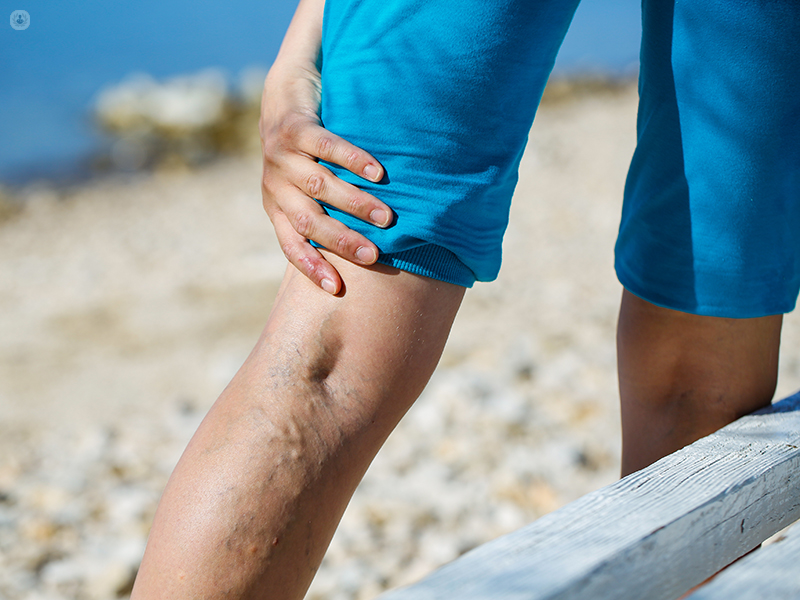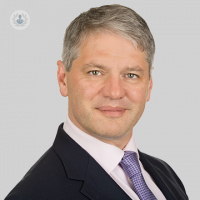What is endovenous laser ablation (EVLA)?
Autore:Endovenous laser ablation is a method of treating varicose veins using a laser and guided imaging to close damaged veins. While it treats underlying veins that lead to the bulging varicose veins that we see on the surface, EVLA alone doesn’t treat the visible surface veins. However, it is one of the best methods of treating the underlying veins to prevent more lumpy surface veins from appearing.
Professor Mark Whiteley tells us more about EVLA, when it was first used, how it works and how much it costs.

When was EVLA first pioneered and practised in the UK?
Professor Whiteley was actually the first surgeon to perform endovenous varicose vein surgery in the UK, along with a vascular technologist. The operation was performed using a radiofrequency catheter to heat the vein rather than laser. There is no record of the first EVLA (laser ablation) which used a laser with a wavelength to heat blood, with the laser fibre being very fine with a narrow end. This wasn’t ideal, as the vein being treated had no blood, so a laser that targeted blood wasn’t a good choice. Secondly, the fine tip resulted in perforations in the veins during treatment causing pain and bruising to the patient.
Now lasers are used that heat water, resulting in more reliable results. The fine tips were also changed and there are now many wavelengths and tips tested at research units like The Whiteley Clinic to discover which combination is optimal for the patient.
Before EVLA
Before 1998 varicose veins were treated with “open surgery” or “stripping”. The underlying saphenous vein (long vein that runs along the leg) was tied at the top, either in the groin or behind the knee and the rest of the vein was stripped out. This was done by passing a wire down the leg, through the skin, then using the wire to pull the vein out of the leg. The bulging surface veins were then hooked out ( phlebectomy ) and left to wither away or were treated with sclerotherapy.
Is EVLA one of the best ways to treat varicose veins?
As there are a number of different veins involved in varicose veins, treatment isn’t so simple. EVLA can be used to treat saphenous veins and in specialist clinics, perforator veins. However, EVLA does not treat the lumpy surface veins. This would risk burning the skin that covers these veins. EVLA is also not used for the treatment of pelvic veins because the heat can damage the bowel, bladder or other vital structures inside the pelvis. Therefore, if varicose veins are the result of venous reflux in the saphenous veins and/or he perforator veins, EVLA is one of the best ways to treat the underlying reflux.
How long does it take veins to disappear after laser treatment?
While EVLA treats underlying venous reflux in saphenous and/or perforator veins that lead to visible varicose veins, it does not treat the visible varicose veins directly. Therefore most vein specialists will combine EVLA with another treatment to treat the surface veins. The surface veins are usually removed with hooks (phlebectomy) which leads to the immediate disappearance of varicose veins. There may be some bruising after the veins have been pulled out, but this will go down once the incisions have healed.
Some doctors will combine EVLA with sclerotherapy wherein the lumpy varicose veins are injected with foam. This works really well for smaller veins. It’s important that patients wear compression stockings for 2-3 weeks after treatment, as failure to compress the veins after sclerotherapy can result in the accumulation of blood, causing clots and staining of the surrounding skin.
Your doctor might also leave the surface varicose veins to shrivel with time. In some cases, the visible veins shrivel over 3-6 months, sometimes sooner. However, for one-third of patients, the visible veins stay lumpy, are very tender, can stain the skin and need further treatment.
So, as we can see the amount of time it takes for surface varicose veins to disappear varies on the techniques used in addition to the EVLA that treats the underlying veins.
Can varicose veins grow back after removal?
The major advantage of using heat (ablation) to close off varicose veins is that provided the right amount of energy is used for the size of the vein being treated, the veins shouldn’t open again. The Whiteley Protocol ensures that every patient has their treatment determined for them depending on the size and type of veins that need treatment. If too little energy is used or given too quickly, the vein clots, eventually the clot gets re-absorbed and the same vein can re-open causing varicose veins to reappear. Too much energy causes burning and pain.
The lumpy varicose veins that are removed by phlebectomy can grow back again. When the veins grow back as a part of the body’s healing process, they won’t grow new valves, so they always grow back as varicose veins. For this reason, The Whiteley Clinic recommend foam sclerotherapy eight weeks after a phlebotomy to interrupt the healing process and reduce the risk of varicose veins coming back.
How much does EVLA cost?
The cost of EVLA depends on:
- The laser device and fibre being used
- Whether one or two legs are being treated
- How many veins need treatment (most doctors check the two main saphenous veins, but good specialists will also check the anterior and posterior saphenous veins as well as perforator veins)
- Cost of the doctor, vascular technologist and clinic
Clinics that offer a quote before looking at a patient will unlikely treat all the relevant veins. As we’ve seen, the successful treatment of varicose veins depends on the treatment of underlying veins, not only the veins visible on the surface.
It’s possible to reduce the price by using a cheaper ultrasound with lower resolution or by leaving out a vascular technologist. However, cheap or free consultations should be regarded with caution as cutting corners in medicine means that quality and results are likely to suffer.
With regards the EVLA itself, prices tend to be around £1,800 for one saphenous vein with optimal equipment and £1,200 if EVLA is used to close incompetent perforator veins using the TRLOP technique. Better equipment with more specialised staff may well result in higher costs. Additional veins will also add to this cost. Again, anything cheaper than this means corners are being cut somewhere in terms of staff, equipment or premises.
If you’d like to know more about the different types of underlying varicose veins or to schedule an appointment with Professor Whiteley, see his article on underlying veins or visit his Top Doctors profile.


